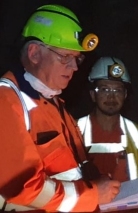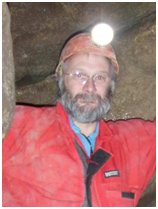HISTORY
Deep Ecton Mine was one of the most important copper mines in Britain in the 18th century. Here there are large flooded workings that extend down to over -300m below river level (Meads, 1858; Figure 4). These had not been seen since the later 1850s after the mine pumps were turned off, until the UNEXMIN project provided information on some of the flooded workings by the use of robot submersibles (see below). The accessible underground passages above the water, and the surface remains, are of national importance as archaeological features that tell of the long history of mining at Ecton and the then ‘state of the art’ mine developed for the Duke of Devonshire in 1760-90.
The history of the Ecton Mines and what survives today have been described in detail by Porter and Robey (2000), Porter (2004) and Barnatt (2013; 2020b). We now know that copper mining here started just under 4000 years ago in the Bronze Age (Timberlake 2014). Lead was mined at small scale in medieval times and miners again became interested in the copper in the 17th century AD. With the dewatering of the ‘pipe’ deposits in the 1720s-30s by a company of ‘Adventurers’, who drove the Deep Ecton Level from next to the River Manifold, exceptionally rich mineral deposits at the heart of the hill were first discovered. The Duke of Devonshire took the mining ‘in-house’ in 1760 and for the next 30 years earned a small fortune. By 1790 the ‘pipe deposits had been followed vertically downwards to about 220m, where they ‘failed’ at depth; below here they were significantly more constricted and became uneconomic. In the first two decades of the 19th century an adjacent deposit, at Clayton Mine, was also followed down to depth. The rest of the nineteenth century was a period when a series of private mining companies tried their luck at Ecton, with funding from investors who knew of Ecton’s profitable past history. These were all short-lived ventures that were wound up once shareholders’ money was gone.
Important archaeological remains at Ecton survive both at surface and underground. High on the ridge there is the 1788 Boulton and Watt steam winding engine house. This is now owned by the National Trust and is thought to be the oldest mine winding engine house in the world that survives in good condition. The shaft here was the deepest in Britain in the 1780s and James Watt designed the first tapered ropes used in the world to bring up the ores here. There are mine hillocks across the ridgetop, dating from the Bronze Age to the 19th century AD, together with entrances to adits, shafts and ‘pipe workings’. The main Deep Ecton dressing floors lie part way up the hillside, on top of a massive waste hillock, and here a high 1880s dressing shed wall with ore bins behind has been restored (Barnatt 2017). Nearby there is a well preserved powder house.
In small dangerous workings on the ridgetop there are distinctive shotholes that show Ecton was one of the first places in Britain where gunpowder blasting was employed, using a continental technique, here by a Dutchman Jacob Mumma in 1665-68.

The snap bench was where miners would sit to eat their snap (lunch)
Salts Level, which from 1807 was used to bring ore out to surface, enters the mine at dressing floor level close to the education centre. It runs through competent rock to the main winding shaft and then the ‘pipe deposit’. This allows education centre groups to easily view a small part of the workings. For many this is their first chance to enter a mine and look down a deep shaft and view impressive mineral workings. There are also important details dating to 1804-07 to see, such as gunpowder shotholes and stone sleeper blocks for an iron plateway that was laid for mine tubs.
Deep Ecton Level, with a fine arched entrance tunnel restored in 2018 (Barnatt 2020a), gives access to the ‘pipe workings’ and for over 150 years was the main way into the mine. Here infrastructure was installed to facilitate mining at depth. From 1773 until 1807 ore from below was unloaded here from the winding shaft for transport to surface. Nearby there are two large 1780s chambers where water was pumped out of the workings using water-powered machines, and items such as tubs and pipes were lowered down using a horse- and man-powered capstan. It is thought the main level was converted to an underground ore canal, used between 1773 and 1784, and we know from documentation that there was a second one at just over 60m down into the now flooded workings.
John Barnatt’s definitive monograph on the history of the Ecton mines: Delving Ever Deeper: The Ecton Mines through Time ISBN 978-0-901428-26-4, Bakewell, Peak District National Park.
Available from Matlock Mining Museum.
You can download a leaflet about this book from here.
A paper to download about the Ecton Mine dressing floor: The Ecton Mines 1880s Dressing Shed Archaeological Evaluation Excavations – November-December 2015 by John Barnatt.
Natural England, Historic England and National Trust information:
- Ecton Copper Mines SSSI
- Hamps and Manifold Valleys SSSI
- Historic England Listing: Copper mines on Ecton Hill
- National Trust: Apes Tor Level, scheduled monument
- National Trust: Ecton Engine House
- Staffordshire RIGS
Downloads:
- Prehistoric Copper Extraction in Britain: Ecton Hill, Staffordshire – paper by Simon Timberlake
- An article by Matthew Parris (The Times, 17 Nov 2011)
- An article by Steve Henley (EMET webmaster) published in Science in Parliament.
- A 1912 article about the Manifold Valley, with a contemporary description of Ecton Mine
- Article about Ecton’s history in Reflections, August 2013



 The powder house, where dangerous explosives were stored. This small shed was placed well away from other buildings and was erected in 1884. The interior was originally lined with wooden panels as an added precaution against accidentally creating sparks.
The powder house, where dangerous explosives were stored. This small shed was placed well away from other buildings and was erected in 1884. The interior was originally lined with wooden panels as an added precaution against accidentally creating sparks.

 was lowered on one side and it was converted to a field barn. The steam engine was located in the far half of the building, while its boiler was in the near half. A short distance upslope there was a small reservoir pond for the boilers fed by water brought up from the mine.
was lowered on one side and it was converted to a field barn. The steam engine was located in the far half of the building, while its boiler was in the near half. A short distance upslope there was a small reservoir pond for the boilers fed by water brought up from the mine.


 In the 1760s-80s the internationally important Deep Ecton Copper Mine made a fortune for the Dukes of Devonshire. The first copper was mined here long before, in the Bronze Age over 3,500 years ago. The Dukes, who owned northern and western parts of the hill, had their mines worked in-house for over 50 years from 1760. From the 1820s private mining companies embarked on a fruitless search for further rich ore deposits. The mines were finally abandoned in 1889. While the 19th century ventures lost investors’ money, with them at best only finding other peoples’ leavings, they kept local miners in work for decades.
In the 1760s-80s the internationally important Deep Ecton Copper Mine made a fortune for the Dukes of Devonshire. The first copper was mined here long before, in the Bronze Age over 3,500 years ago. The Dukes, who owned northern and western parts of the hill, had their mines worked in-house for over 50 years from 1760. From the 1820s private mining companies embarked on a fruitless search for further rich ore deposits. The mines were finally abandoned in 1889. While the 19th century ventures lost investors’ money, with them at best only finding other peoples’ leavings, they kept local miners in work for decades.


 Peter has nearly 50 years experience mostly at the sharp end of the minerals industry. He is a metallurgist who started in the steel industry prior to his degree at Cambridge University. He held senior positions with Anglo American on the Zambian Copperbelt, and at Glebe Mines fluorspar operation in the Derbyshire Peak District; and has been an independent freelance since 2000. He has had connections with Ecton Mine and Geoff Cox since the mid-1980s. He is Secretary of The British Aggregates Association, a member of the CBI Minerals Group and the UK National Minerals Forum; and has various business interests in the industrial minerals industry in the UK, Europe and globally; and is also a Director of MAUK (Mining Association of the UK) and Amemptos Music.
Peter has nearly 50 years experience mostly at the sharp end of the minerals industry. He is a metallurgist who started in the steel industry prior to his degree at Cambridge University. He held senior positions with Anglo American on the Zambian Copperbelt, and at Glebe Mines fluorspar operation in the Derbyshire Peak District; and has been an independent freelance since 2000. He has had connections with Ecton Mine and Geoff Cox since the mid-1980s. He is Secretary of The British Aggregates Association, a member of the CBI Minerals Group and the UK National Minerals Forum; and has various business interests in the industrial minerals industry in the UK, Europe and globally; and is also a Director of MAUK (Mining Association of the UK) and Amemptos Music. I am an exploration and mining geologist (C. Geol) with over 25 years of experience in the deep geological disposal of radioactive waste and 7 years of experience of exploration, environmental impact assessment and mining feasibility for the Kayelekera uranium deposit in Northern Malawi, Africa. I retired from the British Geological Survey in 2016 and am currently a member of the Government’s Committee on Radioactive Waste Disposal. I undertook a PhD on caves and mines in the Peak District and, as an active caver and mine explorer, have been studying the underground world of the Peak District since the mid 1970’s, including the mines of the Ecton Area. I am a director (editor) of the Peak District Mines Historical Society and the mine manager of their Temple Mine in Matlock Bath.
I am an exploration and mining geologist (C. Geol) with over 25 years of experience in the deep geological disposal of radioactive waste and 7 years of experience of exploration, environmental impact assessment and mining feasibility for the Kayelekera uranium deposit in Northern Malawi, Africa. I retired from the British Geological Survey in 2016 and am currently a member of the Government’s Committee on Radioactive Waste Disposal. I undertook a PhD on caves and mines in the Peak District and, as an active caver and mine explorer, have been studying the underground world of the Peak District since the mid 1970’s, including the mines of the Ecton Area. I am a director (editor) of the Peak District Mines Historical Society and the mine manager of their Temple Mine in Matlock Bath. mongst geologists and others involved in the application of geoscience, particularly through the promotion of professional titles such as CEng, CGeol, and EurGeol. She has served on the Council of the Geological Society of London and is a past President of the European Federation of Geologists. For many years, she has been a member of the Pan European Reserves and Resources Reporting Committee (PERC).
mongst geologists and others involved in the application of geoscience, particularly through the promotion of professional titles such as CEng, CGeol, and EurGeol. She has served on the Council of the Geological Society of London and is a past President of the European Federation of Geologists. For many years, she has been a member of the Pan European Reserves and Resources Reporting Committee (PERC). Phil in Organic Chemistry, Nottingham Uni 1977-79, awarded 1981
Phil in Organic Chemistry, Nottingham Uni 1977-79, awarded 1981 I am a geoscientist with more than 45 years of experience. After working as a mine geologist in the Yorkshire Coalfield for 12 years, I moved on to seismic exploration for coal, potash and other minerals focussing on seismic interpretation and delineating geological structure to aid mine planning. My prospect experience includes projects in UK, Spain, Turkey, Australia, Africa, Argentina and Canada.
I am a geoscientist with more than 45 years of experience. After working as a mine geologist in the Yorkshire Coalfield for 12 years, I moved on to seismic exploration for coal, potash and other minerals focussing on seismic interpretation and delineating geological structure to aid mine planning. My prospect experience includes projects in UK, Spain, Turkey, Australia, Africa, Argentina and Canada. ng and engineering around the world. Although I am now retired I continue to hold Board appointments with national and international regulatory and standards organisations which I find professionally stimulating and thoroughly rewarding.
ng and engineering around the world. Although I am now retired I continue to hold Board appointments with national and international regulatory and standards organisations which I find professionally stimulating and thoroughly rewarding.